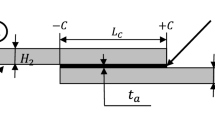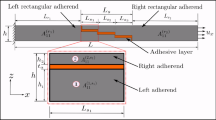Abstract
The focus of this paper was to optimize the interconnection mapping of the adhesive single-lap joints that are bonding composite laminates by utilizing the adherent’s layers’ arrangement method. In this work, as the first step, shear and peeling stress distributions in the adhesive layer of a single lap joint under tensional loading were determined by a 2-D first-order shear deformation theory (FSDT). Subsequently, the stacking sequence of the laminated adherents was optimized by the bees algorithm (BA) in order to reduce the maximum stresses in the adhesive layer. The adhesive layer was assumed to be isotropic while the laminated adherends were assumed to be made of orthotropic laminae. All stresses were determined by an improved closed-form solution based on the deduced displacement fields. The results of the analytical solution were compared with those of finite element solution using ANSYS software, version 13.0. Good agreements were observed between the results of both methods. The results of BA optimization technique were also provided. Results indicated that a decrease in orientation of fiber angles in the laminated adherends would decrease the maximum shear stress in the adhesive layer (and vice versa). Additionally, to decrease the maximum peeling stress, it is crucial that the outer laminae in each adherend layer have a low fiber angle. However, an increase in the fiber angles will increase the maximum peeling stress in the adhesive, causing possible damage to the joint. The presence of high fiber angles in the outer laminae of each adherend layer (away from adhesive-adherend interface) will reduce the peeling stress significantly. However, the presence of such laminae adjacent to the adhesive-adherend interface produces lower shear stress in the adhesive layer.








Similar content being viewed by others
References
Goland M., Reissner E., “The stresses in cemented joints”, J Appl Mech Trans ASME, Trans. ASME., vol. 66, 1944, pp. 17–27
Hart-Smith, L.J. 1986 “Adhesively bonded joints for fibrous composite structures,” International symposium on joining and repair of fiber-reinforced plastics, , pp. 173–210
Zhao B, Lu ZH (2009) A two-dimensional approach of single-lap adhesive bonded joints. Mech Adv Mater Struct 16:130–159
Williams JH (1975) Stresses in adhesive between dissimilar adherents. J Adhes 7:97–107
Ojalvo IU, Eidinoff HL (1978) Bond thickness effects upon stresses in single-lap adhesive joints. AIAA J 16(3):204–211
Bigwood DA, Crocombe AD (1989) Elastic analysis and engineering design formulae for bonded joints. Int J Adhes Adhes 9(4):229–242
Wah T (1973) Stress distribution in bonded anisotropic lap joint. J Eng Mater Technol 95(73):174–181
Mortensen F, Thomsen OT (2002) Coupling effect in adhesive bonded joints. J Comp Struc 56:165–174
Delale F, Erdogan F, Aydinoglu MN (1981) Stresses in adhesively bonded joints: a closed-form solution. J Compos Mater 15:249–271
Allman DJ (1977) A theory for elastic stresses in adhesive bonded lap joints. J Mech Appl Math 30:415–436
Renton WJ, Vinson JR (1977) Analysis of adhesively bonded joints between panels of composite materials. J Appl Mech 44(1):101
da Silva LFM, das Neves PJC, Adams RD, Spelt JK (2009) Analytical models of adhesively bonded joints—part I: literature survey. Int J Adhesion Adhesives 29(3):319–330
Pham D, Ghanbarzadeh A, Koc E, Otri S, Rahim S, Zeidi M (2006) “The bees algorithm, a novel tool for complex optimization problems”, 2nd Int virtual conf on intelligent production machines and systems. Oxford University, Oxford, pp 454–459
Pham, D.T., Castellani, M., Ghanbarzadeh, A., “Preliminary design using the bees algorithm”, Proc eighth international conference on laser metrology, CMM and machine tool performance,Cardiff, Cardiff University, 2007, pp. 420–429
Abbaszadeh, H. 2014 “Optimization of layer arrangement on stress distribution in adhesive joints under bending”, M.Sc thesis, Ahvaz, Islamic Azad University,
Author information
Authors and Affiliations
Corresponding author
Additional information
Publisher’s note
Springer Nature remains neutral with regard to jurisdictional claims in published maps and institutional affiliations.
Recommended for publication by Commission X—Structural Performances of Welded Joints—Fracture Avoidance
Rights and permissions
About this article
Cite this article
Hasanvand, M. Optimization of laminate’s single lap joints by FSDT theory. Weld World 63, 1265–1273 (2019). https://doi.org/10.1007/s40194-019-00755-8
Received:
Accepted:
Published:
Issue Date:
DOI: https://doi.org/10.1007/s40194-019-00755-8




